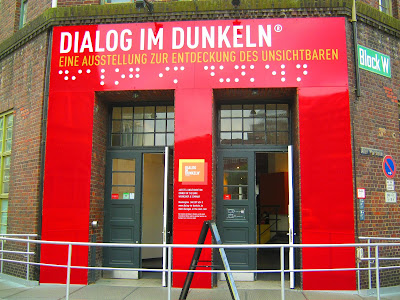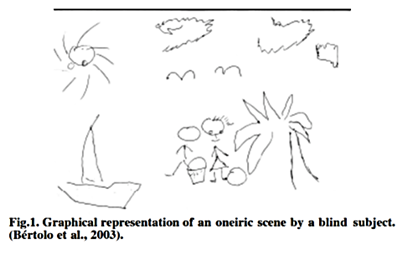|
|

Nunez na Terra dos Cegos - xilogravura de Clifford Web para
'The Country Of the Blind', versão de 1939
There is nothing to see in the Dialog-Museum in Frankfurt am Main, Germany, but
there is much to hear, feel, smell and taste. The museum wants to show what it's
like to be blind. The claim of the museum is that blindness is not simulated,
but experienced as an adventure with (almost) all senses. The website says it
clearly:
"In our exhibition blind guides lead small groups of guests through completely
darkened rooms depicting different everyday situations. Without eyesight, the
daily routine becomes a totally new experience. You will sharpen your senses. A
role reversal is created: Blind people become ambassadors of a culture without
pictures."

Entry to the Dialogue Museum in Frankfurt am Main. Gerhard Kemme
The museum is not alone with this approach. Meanwhile, there are many offers
that seek to enable sighted people to "experience" blindness. Dark restaurants
advertise with their absolutely dark rooms. In these rooms, the senses of the
visitors should change: the "invisible" should be made "visible" with their
hands, their ears, their mouths and their noses. Another example: For a TV
documentary, a reporter attempted to self-test what it would be like to be blind
by wearing opaque glasses and trying to cope with a supposed everyday life.
Many historical museums take other paths when dealing with blindness. As a rule,
they do not try to sell blindness as a happening. Rather, they create additional
information offers to enable blind visitors to visit exhibitions. For example,
the "Museum of the Senses" of the "Roemer and Pelizaeus Museum Hildesheim" has
created an exhibition in which not only audio guides and Braille texts accompany
the exhibition. In addition, they offer exhibits that appeal to the sense of
sight, hearing, touch, smell and taste. For example, it can be "felt", "heard"
and "smelt" as it might have been in ancient Egypt, ancient Peru or China.
Such approaches are important and good. Nevertheless, they raise some questions.
Questions regarding the image of what seeing people make of people who are
blind. It seems that these images are similar to the ideas children have when
they shut their eyes and play "blindly". Often, the stereotype of a problematic
exaggeration of the senses of blind persons is also revealed here, when it is
said: If one cannot see, one can smell better. So the question is: Can seeing
people really get a realistic picture of blindness?

Children playing "blind". Creative Commons Attribution-Share Alike 3.0 Austria
by Erich Schmid (talk)
Firstly, persons who are born blind do not have the reference of seeing.
Therefore, they cannot compare seeing with blindness like sighted people pretend
to do. For most of blind persons not using the sense of sight is a normal state.
Of course, they get told that most of the people around them "see" and get
explained what this so-called seeing means. They are raised in a visual culture
where people talk a lot about how things look like and are visualized. So to
imagine what it means to be blind sighted people would need the life-long
experience and not a couple of hours or days to perceive the same way.
Besides that, there are also technical problems. No one knows how it smelled in
ancient Egypt or what the sound of a city in ancient Peru was like. Such offers
may revive what is actually outdated in historical science, namely the idea that
"the past" could be revived.
It's a good thing that museums are trying to be inclusive as well, of course.
But it will not be enough for non-disabled people to imagine how people with
disabilities could perceive something "different". Sighted people will not be
able to imagine how people who are blind from birth perceive the world. But if
they make use of the idea that blindness could be simulated by eye-witnessing,
in the end, they only strengthen their own stereotypes. Disabled people thus
become objects of non-disabled again.
However, the stereotype of blind people having an increase of tactile or
auditive sensitivity congenitally can easily be disproved. The developmental
psychologist
Lev Vygotsky investigated blind children already 100 years ago. He
defends that this is not a natural inherent process, like a kidney that takes
the role of the failed one but rather this "indicated phenomenon […] proceeds
along a very complicated and roundabout route of overall sociopsychological
compensation, without substituting for or replacing the failing organ."
(Vygotsky 1993: 99)
He argues furthermore that their other senses seem stronger
because blind persons need to do an adaption to the visual world. Therefore they
practice them more. Through listening more closely or touch the Braille letters
with their fingers those daily actions become more and more used to them. For
Vygotsky, the biggest difference between the blind and the sighted is to be seen
in their behaviour, rather than their biological disposition.
Another stereotype is that people who are blind do not have any visual images
and that their world would be "dark". Referring to approaches from Neuroscience
these could show that when imagining pictures, images or memories the same brain
parts of both, sighted and blind persons are active. The neurologist
Helder
Bértolo did research on visual activations in dreams. His results show that
congenitally blind persons have visual contents in their dreams and are even
able to draw them. The experiment suggests the assumption that there can be
visual imagery without visual perception. (Bértolo 2005: 173) So obviously there
seem to be insights into the blind world of perception that sighted people are
not able to see or experience.

Blind subjects were able to represent graphically the oneiric
scenes they previously described orally. No statistical differences were found
between the groups. (Bértolo et al., 2003)
Which ways would have to be gone? Inclusion can only be achieved through
inclusive expertise. People with blindness should therefore not be questioned on
a one-to-one basis as to whether particular offers from an exhibition are
particularly important to them. Rather, they would have to be involved in the
entire process of exhibition design right from the start.
As a good example, the DHM in Berlin offers special exhibitions for blind and
visual impaired visitors since 2015 when developing a concept for an inclusive
museum. Before opening such an exhibition the museum educational service invites
target groups to show them their projected conception. Inasmuch as pre-testing
the exhibition for others they are involved in the planning process. Of course,
it would be even better to include them right from the beginning. Nevertheless,
it can be seen as a start in the right direction of participation and to support
the idea of not talking about or planning for disabled people but of getting
them on the table.
Ultimately, in the context of inclusion and thus a perspective of disability
studies in museums, the question remains: do we have to continue to work with
categorizations, even if categories are generally questioned? Or to put it
another way: can there really be inclusive exhibitions without resorting to
categories of disability? Of course, talking about the category "blind people"
is not unproblematic. "Blindness" is a spectrum, and a lot of people who are
said to be blind have some functional vision. To make it clear: The focus of our
argumentation is on blindborn people with no visual experience. But even this
group is diverse.
On the other hand: it is not only the questioning of the use of categorizations
but furthermore the criticism on how society deals with blindness as such we
should focus more. The cultural model of disability accepts an impairment on the
body side. But beyond that, it asks for the reactions within a predominant abled
society when dealing with disabilities. Certainly, there is a dichotomy that is
repeated over and over again. Sighted vs. Blind. If so contrasted blind persons
often appear as either victims or superheroes. Both ways are not appropriate.
Something that sighted people could actually learn from experiments of playing
blind is to question the massive priority that seeing has in our culture and to
challenge the concept of ability as such.
Closing with a perspective change from H.G. Wells –
The country of the blind:
When the main character Nuñez climbed Ecuador‘s Andes and got lost out there
coincidentally he found a country where everybody was blind from birth. After
observing them for a while the first thing he wanted to do was to teach the
blind population how to "see". But since they did not have a concept of seeing
like he did they considered him being crazy. He tried to trick them by running
away assuming they could not see and therefore follow him. He tried his best to
convince them that they had a deficit and that a normal state would be to "see"
the world through "eyes". But neither did they believe him nor where their
special perception really deficit enough to let him escape from them. They made
him obey and he had to follow. In their notion, he alone was abnormal because he
seemed to have tumour-like shapes in his face and was constantly talking about
this so-called "seeing" which they figured must have been some kind of mental
disease.
References:
-
Bértolo, Helder (2005): »Visual imagery without visual perception?« In:
Psicológica: Revista de metodologia y psicologia experimental Bd. 26, p.173-188.
-
Vygotsky, Lev (1993): »The blind child«, in: Robert W. Rieber/Aaron S. Carton
(Hg.), The collected works of L. S. Vygotsky Volume 2: The Fundamentals of
Defectology. Abnormal Psychology and Learning Disabilities, New York/London:
Plenum Press, p. 97-109.
ϟ
Sebastian Barsch is professor for History Didactics at the University of Kiel.
&
Susan Krause is doctoral researcher at the University of Bielefeld.
|